Nestlé Sri Lanka's Corporate Social Responsibility and Sustainability
VerifiedAdded on 2023/05/28
|15
|3065
|349
Report
AI Summary
This report provides an in-depth analysis of Nestlé's corporate social responsibility (CSR) and sustainability initiatives in Sri Lanka. It highlights the company's Creating Shared Value model, which aligns business interests with the needs of local communities, focusing on areas such as milk production, farming, and supply chain management. The report explores Nestlé's strategies for environmental sustainability, including greenhouse gas emission reduction, afforestation programs, and water conservation efforts. It also examines the company's commitment to ethical labor practices, stakeholder involvement, and transparent reporting. Furthermore, the report provides recommendations for Nestlé to enhance its CSR and sustainability performance, emphasizing innovation and collaboration with employees and suppliers. The analysis demonstrates Nestlé's efforts to balance economic success with social and environmental responsibility in its Sri Lankan operations.

Corporate Social Responsibility and Sustainability 1
CORPORATE SOCIAL RESPONSIBILITY AND SUSTAINABILITY
By (Student Name)
CORPORATE SOCIAL RESPONSIBILITY AND SUSTAINABILITY
By (Student Name)
Paraphrase This Document
Need a fresh take? Get an instant paraphrase of this document with our AI Paraphraser
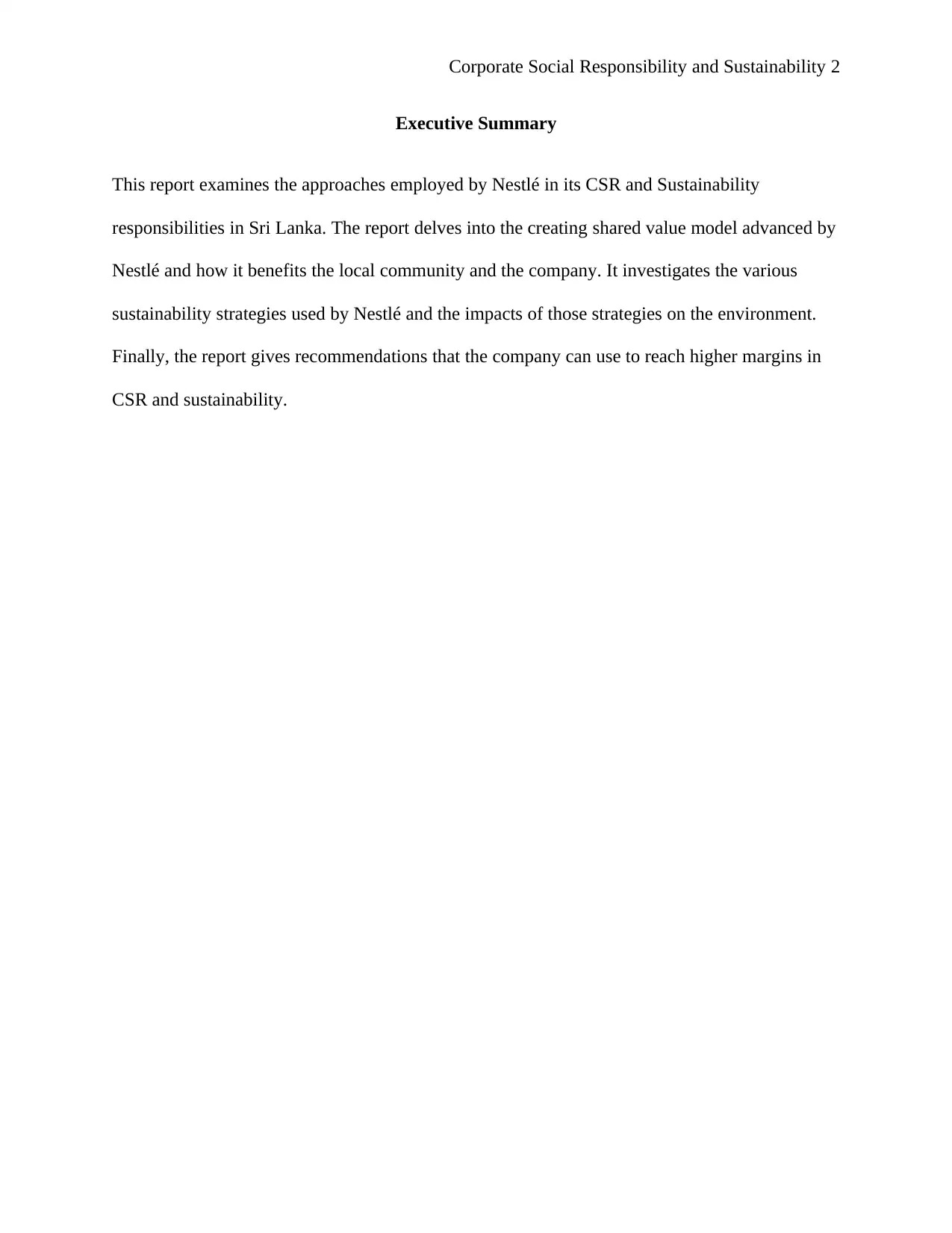
Corporate Social Responsibility and Sustainability 2
Executive Summary
This report examines the approaches employed by Nestlé in its CSR and Sustainability
responsibilities in Sri Lanka. The report delves into the creating shared value model advanced by
Nestlé and how it benefits the local community and the company. It investigates the various
sustainability strategies used by Nestlé and the impacts of those strategies on the environment.
Finally, the report gives recommendations that the company can use to reach higher margins in
CSR and sustainability.
Executive Summary
This report examines the approaches employed by Nestlé in its CSR and Sustainability
responsibilities in Sri Lanka. The report delves into the creating shared value model advanced by
Nestlé and how it benefits the local community and the company. It investigates the various
sustainability strategies used by Nestlé and the impacts of those strategies on the environment.
Finally, the report gives recommendations that the company can use to reach higher margins in
CSR and sustainability.
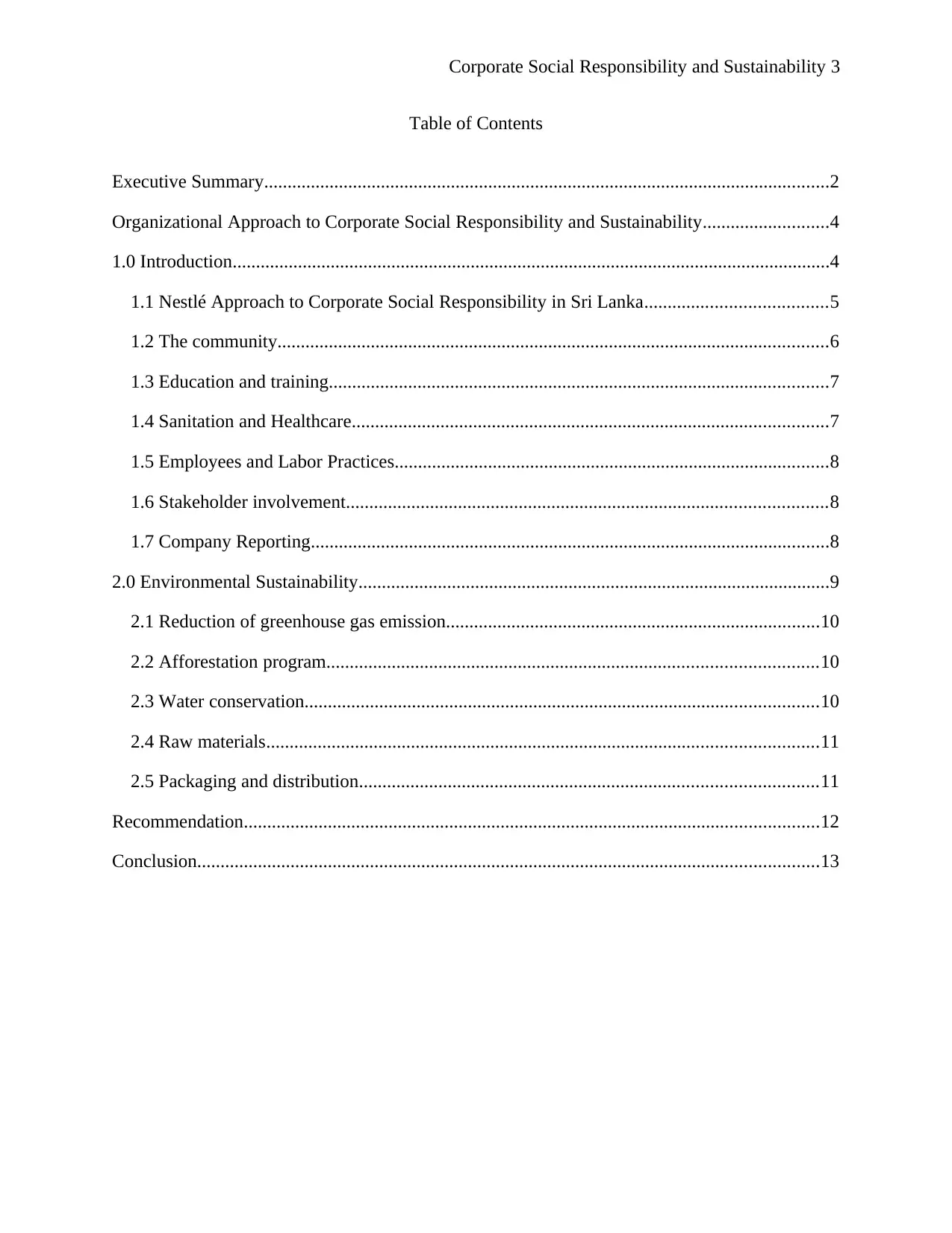
Corporate Social Responsibility and Sustainability 3
Table of Contents
Executive Summary.........................................................................................................................2
Organizational Approach to Corporate Social Responsibility and Sustainability...........................4
1.0 Introduction................................................................................................................................4
1.1 Nestlé Approach to Corporate Social Responsibility in Sri Lanka.......................................5
1.2 The community......................................................................................................................6
1.3 Education and training...........................................................................................................7
1.4 Sanitation and Healthcare......................................................................................................7
1.5 Employees and Labor Practices.............................................................................................8
1.6 Stakeholder involvement.......................................................................................................8
1.7 Company Reporting...............................................................................................................8
2.0 Environmental Sustainability.....................................................................................................9
2.1 Reduction of greenhouse gas emission................................................................................10
2.2 Afforestation program.........................................................................................................10
2.3 Water conservation..............................................................................................................10
2.4 Raw materials......................................................................................................................11
2.5 Packaging and distribution..................................................................................................11
Recommendation...........................................................................................................................12
Conclusion.....................................................................................................................................13
Table of Contents
Executive Summary.........................................................................................................................2
Organizational Approach to Corporate Social Responsibility and Sustainability...........................4
1.0 Introduction................................................................................................................................4
1.1 Nestlé Approach to Corporate Social Responsibility in Sri Lanka.......................................5
1.2 The community......................................................................................................................6
1.3 Education and training...........................................................................................................7
1.4 Sanitation and Healthcare......................................................................................................7
1.5 Employees and Labor Practices.............................................................................................8
1.6 Stakeholder involvement.......................................................................................................8
1.7 Company Reporting...............................................................................................................8
2.0 Environmental Sustainability.....................................................................................................9
2.1 Reduction of greenhouse gas emission................................................................................10
2.2 Afforestation program.........................................................................................................10
2.3 Water conservation..............................................................................................................10
2.4 Raw materials......................................................................................................................11
2.5 Packaging and distribution..................................................................................................11
Recommendation...........................................................................................................................12
Conclusion.....................................................................................................................................13
⊘ This is a preview!⊘
Do you want full access?
Subscribe today to unlock all pages.

Trusted by 1+ million students worldwide

Corporate Social Responsibility and Sustainability 4
Organizational Approach to Corporate Social Responsibility and Sustainability
1.0 Introduction
Corporate social responsibility has become an essential duty of businesses today in
meeting their duty of care to the stakeholders where they operate. Many businesses realize that
they do not operate in a vacuum and require to involve local communities, local governments,
civil society organizations, suppliers and non-governmental organizations in their operations
(Leventhal 2018).
There has been heated debate simmering on the role of businesses in corporate social
responsibility and sustainability strategies. Opponents infer that businesses exist for one reason,
to maximize shareholder wealth and that all activities negating from that aspect are mere window
dressing affairs (Paun 2018; Sethi 2012). Visser (2010), for instance, posits that though many
companies claim involvement in CSR and sustainability, social problems have grown not
reduced and that climatic vagaries have gone a notch higher. He proposes CSR 2 or in short
corporate sustainability and responsibility where companies align their business strategies to
community problems hence benefitting both parties.
Other experts such as Porter and Kramer (2011) share the same thoughts. They propose a
model called Creating Shared Value, which has been executed very successfully at Nestlé. The
model aligns business interests to those of local communities thereby ensuring not only
sustainable livelihoods for local communities but also successful business performance.
Organizational Approach to Corporate Social Responsibility and Sustainability
1.0 Introduction
Corporate social responsibility has become an essential duty of businesses today in
meeting their duty of care to the stakeholders where they operate. Many businesses realize that
they do not operate in a vacuum and require to involve local communities, local governments,
civil society organizations, suppliers and non-governmental organizations in their operations
(Leventhal 2018).
There has been heated debate simmering on the role of businesses in corporate social
responsibility and sustainability strategies. Opponents infer that businesses exist for one reason,
to maximize shareholder wealth and that all activities negating from that aspect are mere window
dressing affairs (Paun 2018; Sethi 2012). Visser (2010), for instance, posits that though many
companies claim involvement in CSR and sustainability, social problems have grown not
reduced and that climatic vagaries have gone a notch higher. He proposes CSR 2 or in short
corporate sustainability and responsibility where companies align their business strategies to
community problems hence benefitting both parties.
Other experts such as Porter and Kramer (2011) share the same thoughts. They propose a
model called Creating Shared Value, which has been executed very successfully at Nestlé. The
model aligns business interests to those of local communities thereby ensuring not only
sustainable livelihoods for local communities but also successful business performance.
Paraphrase This Document
Need a fresh take? Get an instant paraphrase of this document with our AI Paraphraser
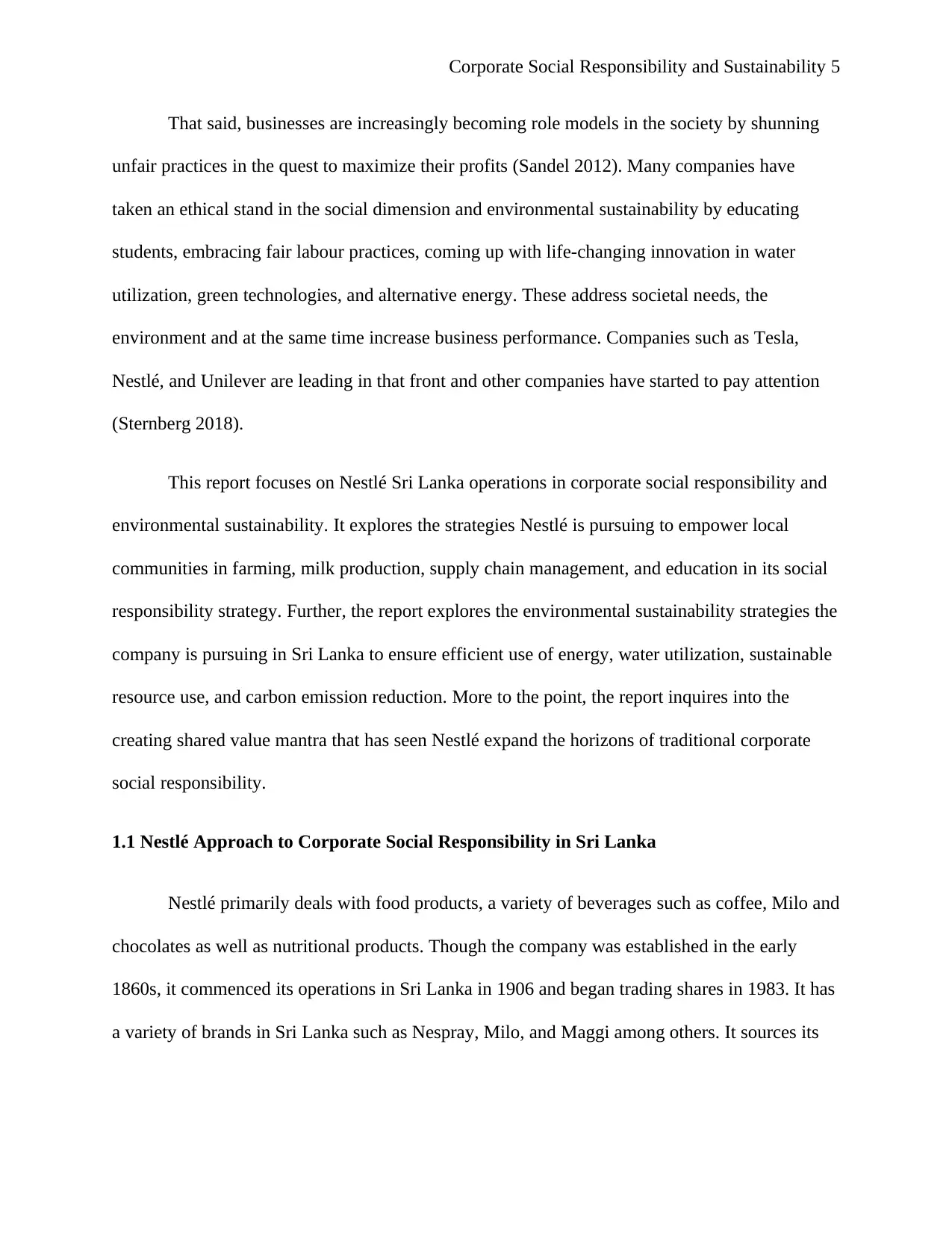
Corporate Social Responsibility and Sustainability 5
That said, businesses are increasingly becoming role models in the society by shunning
unfair practices in the quest to maximize their profits (Sandel 2012). Many companies have
taken an ethical stand in the social dimension and environmental sustainability by educating
students, embracing fair labour practices, coming up with life-changing innovation in water
utilization, green technologies, and alternative energy. These address societal needs, the
environment and at the same time increase business performance. Companies such as Tesla,
Nestlé, and Unilever are leading in that front and other companies have started to pay attention
(Sternberg 2018).
This report focuses on Nestlé Sri Lanka operations in corporate social responsibility and
environmental sustainability. It explores the strategies Nestlé is pursuing to empower local
communities in farming, milk production, supply chain management, and education in its social
responsibility strategy. Further, the report explores the environmental sustainability strategies the
company is pursuing in Sri Lanka to ensure efficient use of energy, water utilization, sustainable
resource use, and carbon emission reduction. More to the point, the report inquires into the
creating shared value mantra that has seen Nestlé expand the horizons of traditional corporate
social responsibility.
1.1 Nestlé Approach to Corporate Social Responsibility in Sri Lanka
Nestlé primarily deals with food products, a variety of beverages such as coffee, Milo and
chocolates as well as nutritional products. Though the company was established in the early
1860s, it commenced its operations in Sri Lanka in 1906 and began trading shares in 1983. It has
a variety of brands in Sri Lanka such as Nespray, Milo, and Maggi among others. It sources its
That said, businesses are increasingly becoming role models in the society by shunning
unfair practices in the quest to maximize their profits (Sandel 2012). Many companies have
taken an ethical stand in the social dimension and environmental sustainability by educating
students, embracing fair labour practices, coming up with life-changing innovation in water
utilization, green technologies, and alternative energy. These address societal needs, the
environment and at the same time increase business performance. Companies such as Tesla,
Nestlé, and Unilever are leading in that front and other companies have started to pay attention
(Sternberg 2018).
This report focuses on Nestlé Sri Lanka operations in corporate social responsibility and
environmental sustainability. It explores the strategies Nestlé is pursuing to empower local
communities in farming, milk production, supply chain management, and education in its social
responsibility strategy. Further, the report explores the environmental sustainability strategies the
company is pursuing in Sri Lanka to ensure efficient use of energy, water utilization, sustainable
resource use, and carbon emission reduction. More to the point, the report inquires into the
creating shared value mantra that has seen Nestlé expand the horizons of traditional corporate
social responsibility.
1.1 Nestlé Approach to Corporate Social Responsibility in Sri Lanka
Nestlé primarily deals with food products, a variety of beverages such as coffee, Milo and
chocolates as well as nutritional products. Though the company was established in the early
1860s, it commenced its operations in Sri Lanka in 1906 and began trading shares in 1983. It has
a variety of brands in Sri Lanka such as Nespray, Milo, and Maggi among others. It sources its
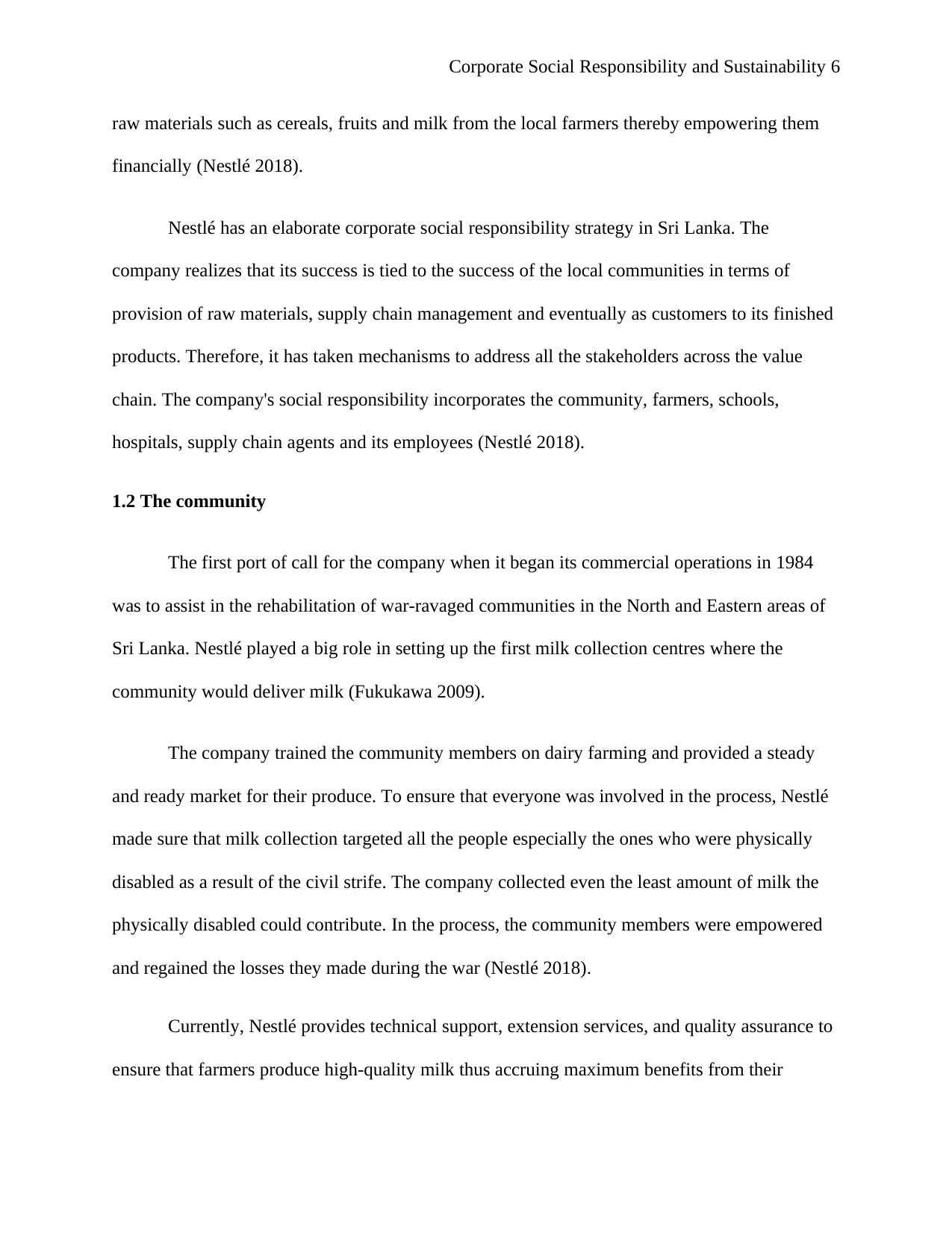
Corporate Social Responsibility and Sustainability 6
raw materials such as cereals, fruits and milk from the local farmers thereby empowering them
financially (Nestlé 2018).
Nestlé has an elaborate corporate social responsibility strategy in Sri Lanka. The
company realizes that its success is tied to the success of the local communities in terms of
provision of raw materials, supply chain management and eventually as customers to its finished
products. Therefore, it has taken mechanisms to address all the stakeholders across the value
chain. The company's social responsibility incorporates the community, farmers, schools,
hospitals, supply chain agents and its employees (Nestlé 2018).
1.2 The community
The first port of call for the company when it began its commercial operations in 1984
was to assist in the rehabilitation of war-ravaged communities in the North and Eastern areas of
Sri Lanka. Nestlé played a big role in setting up the first milk collection centres where the
community would deliver milk (Fukukawa 2009).
The company trained the community members on dairy farming and provided a steady
and ready market for their produce. To ensure that everyone was involved in the process, Nestlé
made sure that milk collection targeted all the people especially the ones who were physically
disabled as a result of the civil strife. The company collected even the least amount of milk the
physically disabled could contribute. In the process, the community members were empowered
and regained the losses they made during the war (Nestlé 2018).
Currently, Nestlé provides technical support, extension services, and quality assurance to
ensure that farmers produce high-quality milk thus accruing maximum benefits from their
raw materials such as cereals, fruits and milk from the local farmers thereby empowering them
financially (Nestlé 2018).
Nestlé has an elaborate corporate social responsibility strategy in Sri Lanka. The
company realizes that its success is tied to the success of the local communities in terms of
provision of raw materials, supply chain management and eventually as customers to its finished
products. Therefore, it has taken mechanisms to address all the stakeholders across the value
chain. The company's social responsibility incorporates the community, farmers, schools,
hospitals, supply chain agents and its employees (Nestlé 2018).
1.2 The community
The first port of call for the company when it began its commercial operations in 1984
was to assist in the rehabilitation of war-ravaged communities in the North and Eastern areas of
Sri Lanka. Nestlé played a big role in setting up the first milk collection centres where the
community would deliver milk (Fukukawa 2009).
The company trained the community members on dairy farming and provided a steady
and ready market for their produce. To ensure that everyone was involved in the process, Nestlé
made sure that milk collection targeted all the people especially the ones who were physically
disabled as a result of the civil strife. The company collected even the least amount of milk the
physically disabled could contribute. In the process, the community members were empowered
and regained the losses they made during the war (Nestlé 2018).
Currently, Nestlé provides technical support, extension services, and quality assurance to
ensure that farmers produce high-quality milk thus accruing maximum benefits from their
⊘ This is a preview!⊘
Do you want full access?
Subscribe today to unlock all pages.

Trusted by 1+ million students worldwide

Corporate Social Responsibility and Sustainability 7
efforts. The company actions have directly impacted the living conditions of over 24,000
farmers. Indirectly, the company has impacted over a hundred thousand people in transportation,
logistics, and retail business (Mia et al. 2015).
1.3 Education and training
The company has helped community members to acquire technical skills in modern
agriculture. This has been achieved through the provision of agricultural extension workers who
train local farmers on superior farming technology (Porter & Kramer 2011).
On education, Nestlé has helped to rehabilitate schools in Pannala and Makandura among
other areas. This has impacted directly on the education of over 7000 students. Nestlé
understands that by empowering the children, the community is uplifted and this forms a stable
bedrock for its future customers (Nestlé 2018).
1.4 Sanitation and Healthcare
The company recognizes that over a billion people in South-Asia lack proper sanitation
facilities. This has the potential to affect the health of millions through waterborne
communicable diseases. The company's contribution to solving the problem was through
investment in modern sanitation facilities in local community schools and hospitals. This has
helped Sri Lanka's bid to achieve millennium development goal 4 on the reduction of infant
mortality. The company has set up over 20 sanitation facilities that directly impact over 5000
students and community members (Nestlé 2018).
efforts. The company actions have directly impacted the living conditions of over 24,000
farmers. Indirectly, the company has impacted over a hundred thousand people in transportation,
logistics, and retail business (Mia et al. 2015).
1.3 Education and training
The company has helped community members to acquire technical skills in modern
agriculture. This has been achieved through the provision of agricultural extension workers who
train local farmers on superior farming technology (Porter & Kramer 2011).
On education, Nestlé has helped to rehabilitate schools in Pannala and Makandura among
other areas. This has impacted directly on the education of over 7000 students. Nestlé
understands that by empowering the children, the community is uplifted and this forms a stable
bedrock for its future customers (Nestlé 2018).
1.4 Sanitation and Healthcare
The company recognizes that over a billion people in South-Asia lack proper sanitation
facilities. This has the potential to affect the health of millions through waterborne
communicable diseases. The company's contribution to solving the problem was through
investment in modern sanitation facilities in local community schools and hospitals. This has
helped Sri Lanka's bid to achieve millennium development goal 4 on the reduction of infant
mortality. The company has set up over 20 sanitation facilities that directly impact over 5000
students and community members (Nestlé 2018).
Paraphrase This Document
Need a fresh take? Get an instant paraphrase of this document with our AI Paraphraser
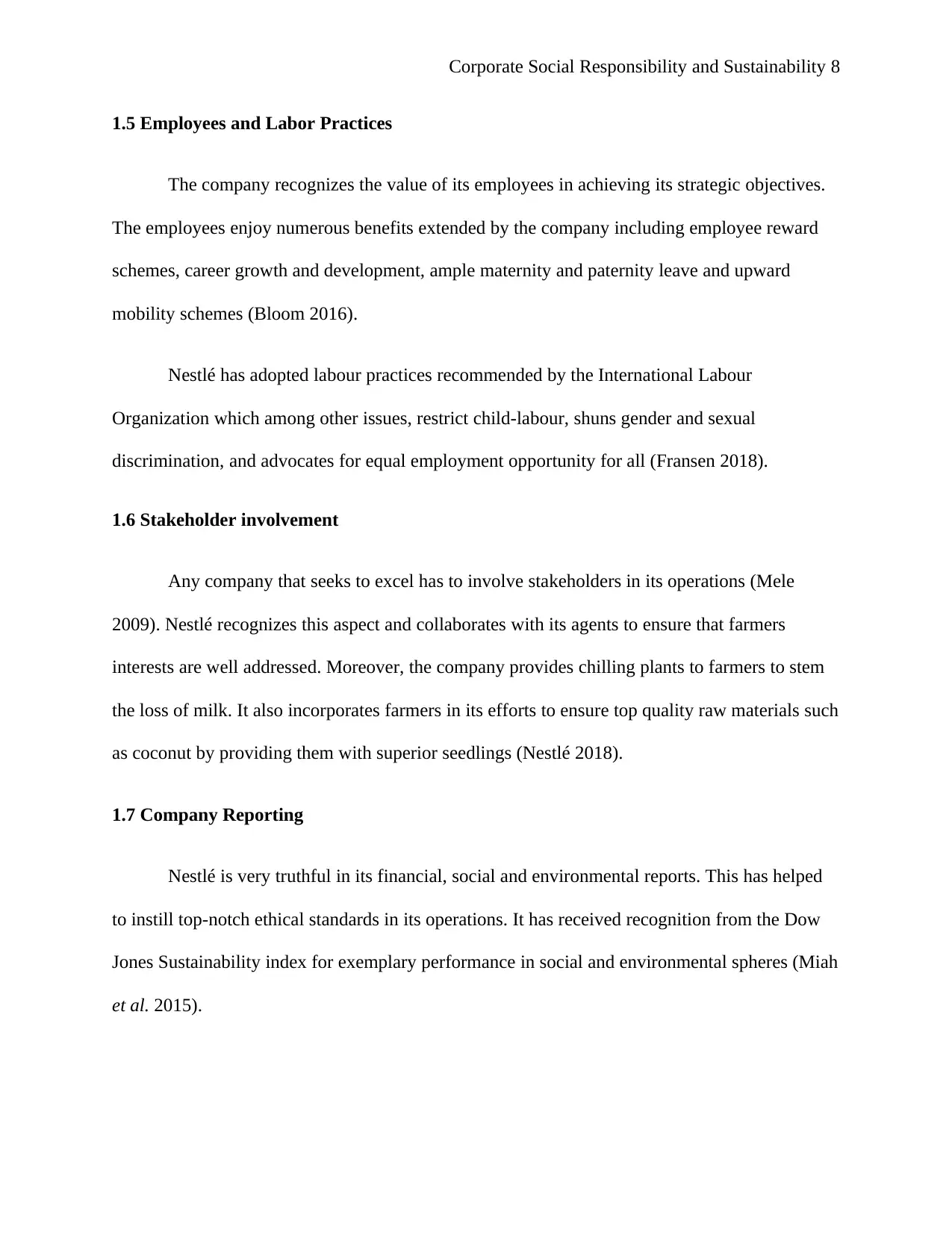
Corporate Social Responsibility and Sustainability 8
1.5 Employees and Labor Practices
The company recognizes the value of its employees in achieving its strategic objectives.
The employees enjoy numerous benefits extended by the company including employee reward
schemes, career growth and development, ample maternity and paternity leave and upward
mobility schemes (Bloom 2016).
Nestlé has adopted labour practices recommended by the International Labour
Organization which among other issues, restrict child-labour, shuns gender and sexual
discrimination, and advocates for equal employment opportunity for all (Fransen 2018).
1.6 Stakeholder involvement
Any company that seeks to excel has to involve stakeholders in its operations (Mele
2009). Nestlé recognizes this aspect and collaborates with its agents to ensure that farmers
interests are well addressed. Moreover, the company provides chilling plants to farmers to stem
the loss of milk. It also incorporates farmers in its efforts to ensure top quality raw materials such
as coconut by providing them with superior seedlings (Nestlé 2018).
1.7 Company Reporting
Nestlé is very truthful in its financial, social and environmental reports. This has helped
to instill top-notch ethical standards in its operations. It has received recognition from the Dow
Jones Sustainability index for exemplary performance in social and environmental spheres (Miah
et al. 2015).
1.5 Employees and Labor Practices
The company recognizes the value of its employees in achieving its strategic objectives.
The employees enjoy numerous benefits extended by the company including employee reward
schemes, career growth and development, ample maternity and paternity leave and upward
mobility schemes (Bloom 2016).
Nestlé has adopted labour practices recommended by the International Labour
Organization which among other issues, restrict child-labour, shuns gender and sexual
discrimination, and advocates for equal employment opportunity for all (Fransen 2018).
1.6 Stakeholder involvement
Any company that seeks to excel has to involve stakeholders in its operations (Mele
2009). Nestlé recognizes this aspect and collaborates with its agents to ensure that farmers
interests are well addressed. Moreover, the company provides chilling plants to farmers to stem
the loss of milk. It also incorporates farmers in its efforts to ensure top quality raw materials such
as coconut by providing them with superior seedlings (Nestlé 2018).
1.7 Company Reporting
Nestlé is very truthful in its financial, social and environmental reports. This has helped
to instill top-notch ethical standards in its operations. It has received recognition from the Dow
Jones Sustainability index for exemplary performance in social and environmental spheres (Miah
et al. 2015).
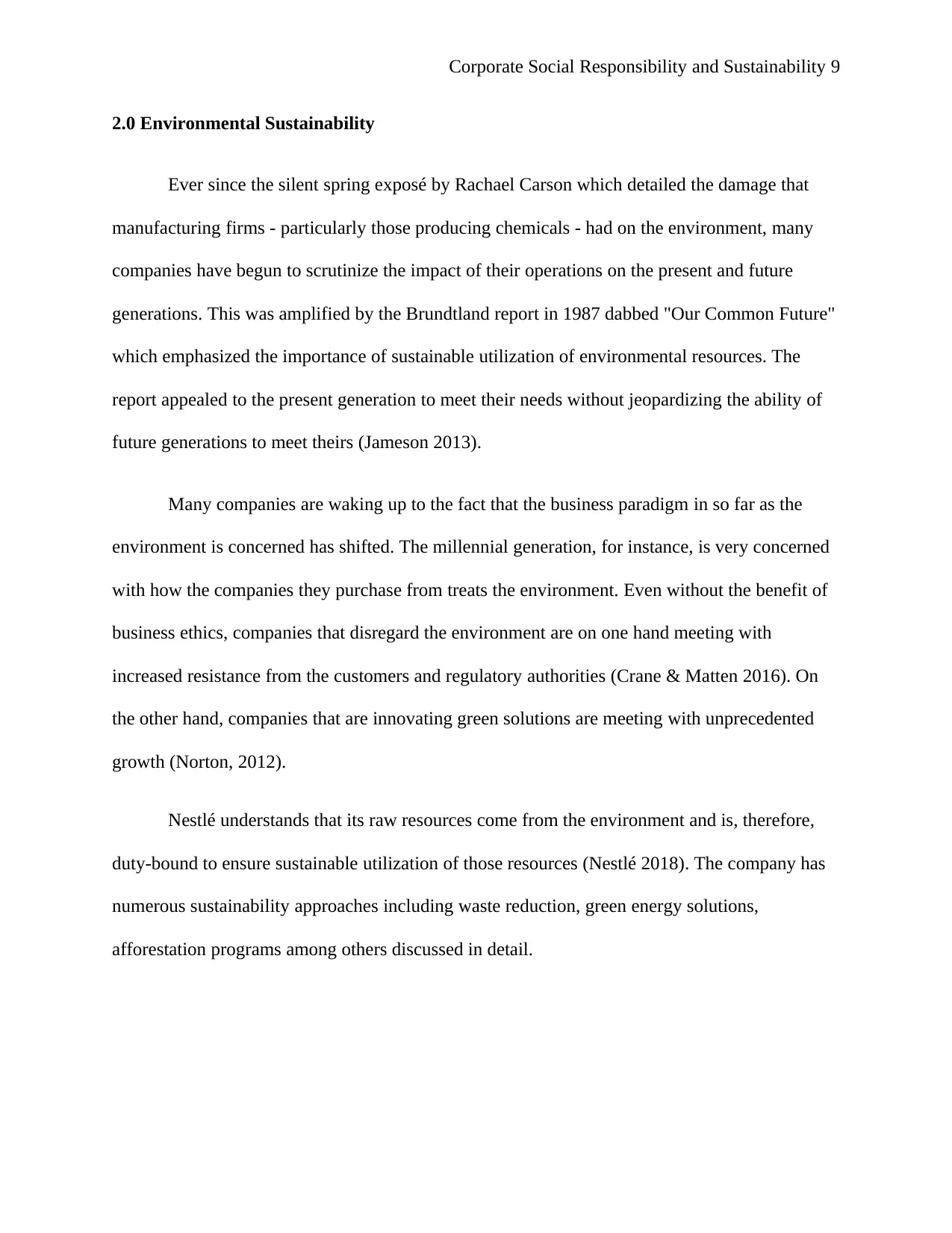
Corporate Social Responsibility and Sustainability 9
2.0 Environmental Sustainability
Ever since the silent spring exposé by Rachael Carson which detailed the damage that
manufacturing firms - particularly those producing chemicals - had on the environment, many
companies have begun to scrutinize the impact of their operations on the present and future
generations. This was amplified by the Brundtland report in 1987 dabbed "Our Common Future"
which emphasized the importance of sustainable utilization of environmental resources. The
report appealed to the present generation to meet their needs without jeopardizing the ability of
future generations to meet theirs (Jameson 2013).
Many companies are waking up to the fact that the business paradigm in so far as the
environment is concerned has shifted. The millennial generation, for instance, is very concerned
with how the companies they purchase from treats the environment. Even without the benefit of
business ethics, companies that disregard the environment are on one hand meeting with
increased resistance from the customers and regulatory authorities (Crane & Matten 2016). On
the other hand, companies that are innovating green solutions are meeting with unprecedented
growth (Norton, 2012).
Nestlé understands that its raw resources come from the environment and is, therefore,
duty-bound to ensure sustainable utilization of those resources (Nestlé 2018). The company has
numerous sustainability approaches including waste reduction, green energy solutions,
afforestation programs among others discussed in detail.
2.0 Environmental Sustainability
Ever since the silent spring exposé by Rachael Carson which detailed the damage that
manufacturing firms - particularly those producing chemicals - had on the environment, many
companies have begun to scrutinize the impact of their operations on the present and future
generations. This was amplified by the Brundtland report in 1987 dabbed "Our Common Future"
which emphasized the importance of sustainable utilization of environmental resources. The
report appealed to the present generation to meet their needs without jeopardizing the ability of
future generations to meet theirs (Jameson 2013).
Many companies are waking up to the fact that the business paradigm in so far as the
environment is concerned has shifted. The millennial generation, for instance, is very concerned
with how the companies they purchase from treats the environment. Even without the benefit of
business ethics, companies that disregard the environment are on one hand meeting with
increased resistance from the customers and regulatory authorities (Crane & Matten 2016). On
the other hand, companies that are innovating green solutions are meeting with unprecedented
growth (Norton, 2012).
Nestlé understands that its raw resources come from the environment and is, therefore,
duty-bound to ensure sustainable utilization of those resources (Nestlé 2018). The company has
numerous sustainability approaches including waste reduction, green energy solutions,
afforestation programs among others discussed in detail.
⊘ This is a preview!⊘
Do you want full access?
Subscribe today to unlock all pages.

Trusted by 1+ million students worldwide
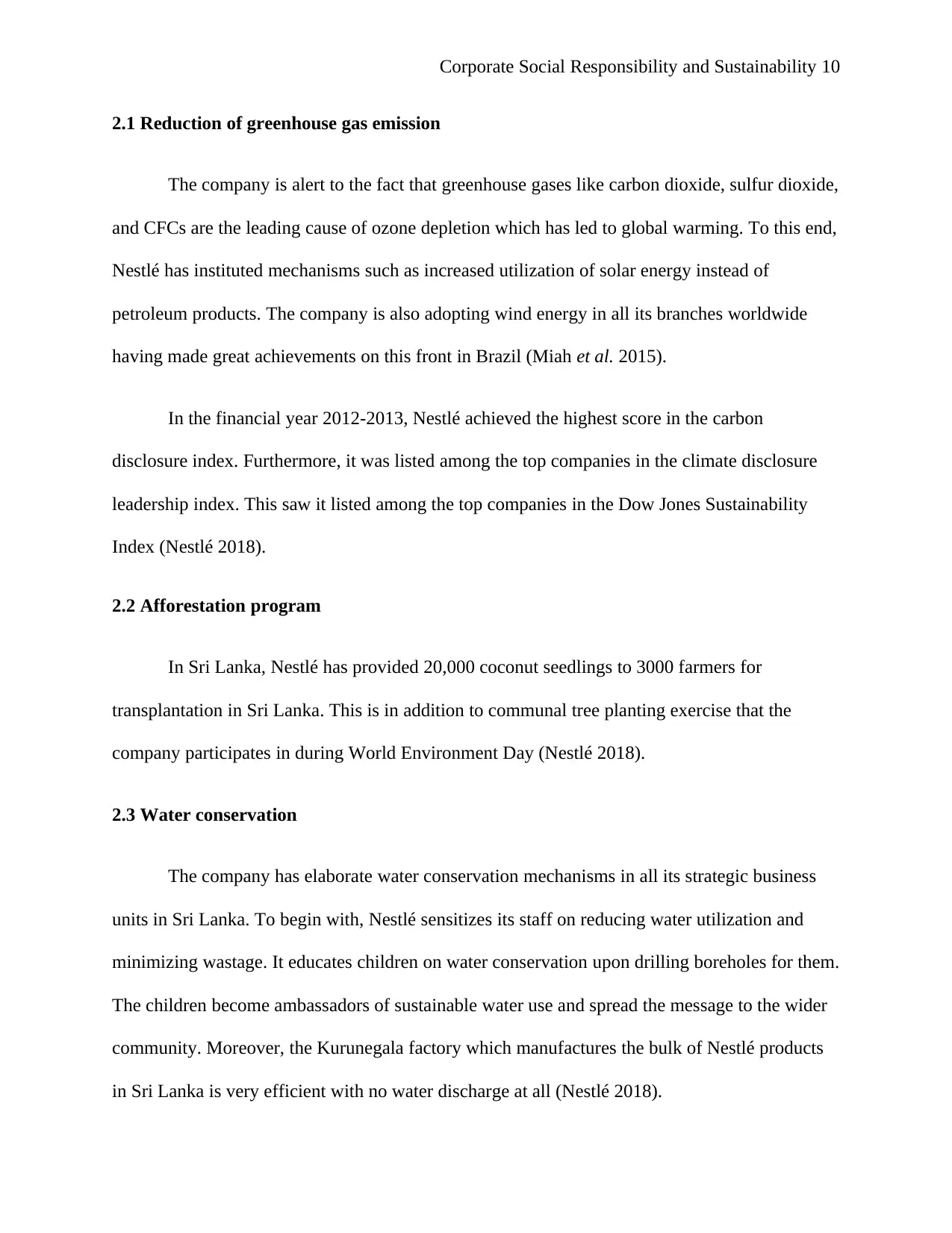
Corporate Social Responsibility and Sustainability 10
2.1 Reduction of greenhouse gas emission
The company is alert to the fact that greenhouse gases like carbon dioxide, sulfur dioxide,
and CFCs are the leading cause of ozone depletion which has led to global warming. To this end,
Nestlé has instituted mechanisms such as increased utilization of solar energy instead of
petroleum products. The company is also adopting wind energy in all its branches worldwide
having made great achievements on this front in Brazil (Miah et al. 2015).
In the financial year 2012-2013, Nestlé achieved the highest score in the carbon
disclosure index. Furthermore, it was listed among the top companies in the climate disclosure
leadership index. This saw it listed among the top companies in the Dow Jones Sustainability
Index (Nestlé 2018).
2.2 Afforestation program
In Sri Lanka, Nestlé has provided 20,000 coconut seedlings to 3000 farmers for
transplantation in Sri Lanka. This is in addition to communal tree planting exercise that the
company participates in during World Environment Day (Nestlé 2018).
2.3 Water conservation
The company has elaborate water conservation mechanisms in all its strategic business
units in Sri Lanka. To begin with, Nestlé sensitizes its staff on reducing water utilization and
minimizing wastage. It educates children on water conservation upon drilling boreholes for them.
The children become ambassadors of sustainable water use and spread the message to the wider
community. Moreover, the Kurunegala factory which manufactures the bulk of Nestlé products
in Sri Lanka is very efficient with no water discharge at all (Nestlé 2018).
2.1 Reduction of greenhouse gas emission
The company is alert to the fact that greenhouse gases like carbon dioxide, sulfur dioxide,
and CFCs are the leading cause of ozone depletion which has led to global warming. To this end,
Nestlé has instituted mechanisms such as increased utilization of solar energy instead of
petroleum products. The company is also adopting wind energy in all its branches worldwide
having made great achievements on this front in Brazil (Miah et al. 2015).
In the financial year 2012-2013, Nestlé achieved the highest score in the carbon
disclosure index. Furthermore, it was listed among the top companies in the climate disclosure
leadership index. This saw it listed among the top companies in the Dow Jones Sustainability
Index (Nestlé 2018).
2.2 Afforestation program
In Sri Lanka, Nestlé has provided 20,000 coconut seedlings to 3000 farmers for
transplantation in Sri Lanka. This is in addition to communal tree planting exercise that the
company participates in during World Environment Day (Nestlé 2018).
2.3 Water conservation
The company has elaborate water conservation mechanisms in all its strategic business
units in Sri Lanka. To begin with, Nestlé sensitizes its staff on reducing water utilization and
minimizing wastage. It educates children on water conservation upon drilling boreholes for them.
The children become ambassadors of sustainable water use and spread the message to the wider
community. Moreover, the Kurunegala factory which manufactures the bulk of Nestlé products
in Sri Lanka is very efficient with no water discharge at all (Nestlé 2018).
Paraphrase This Document
Need a fresh take? Get an instant paraphrase of this document with our AI Paraphraser
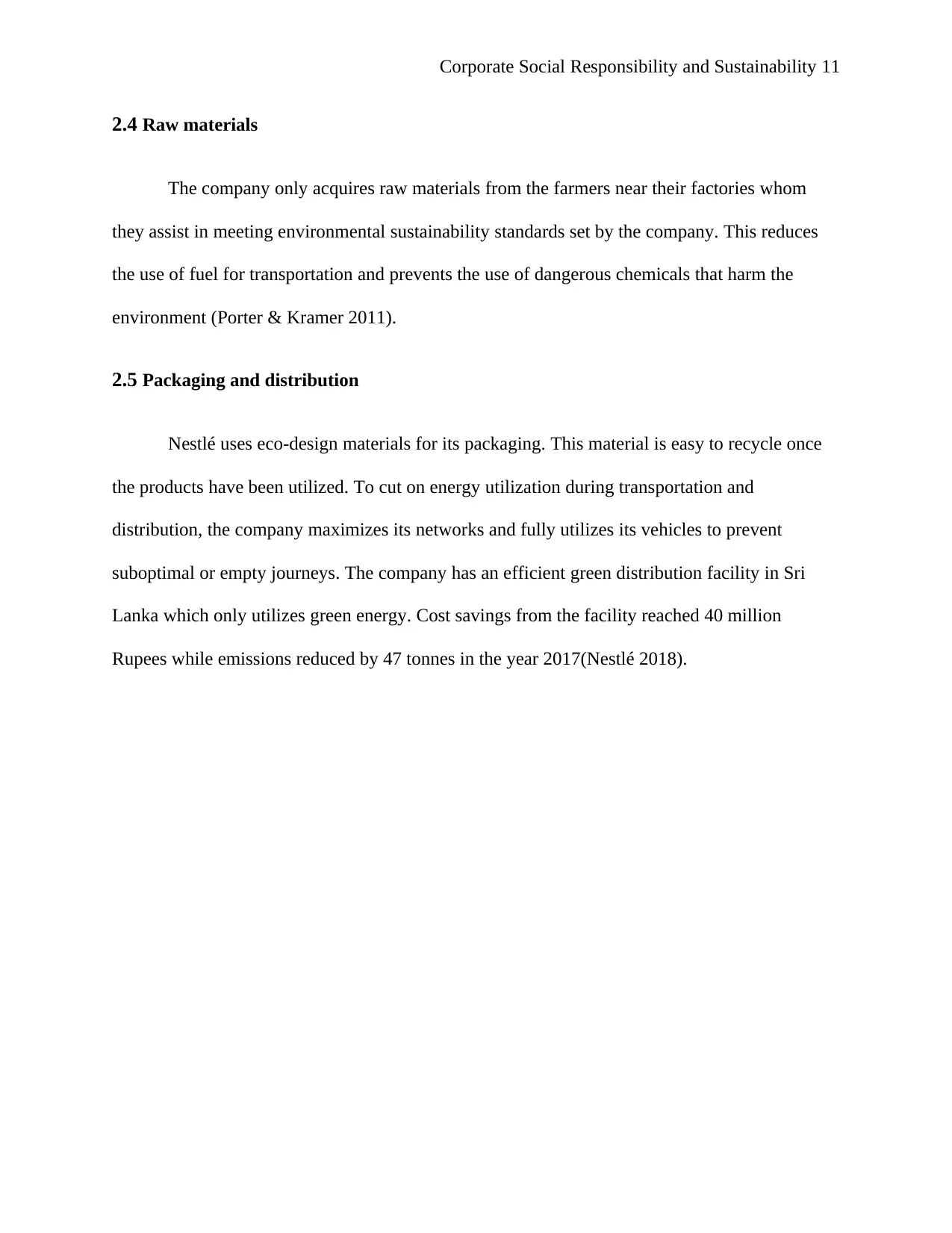
Corporate Social Responsibility and Sustainability 11
2.4 Raw materials
The company only acquires raw materials from the farmers near their factories whom
they assist in meeting environmental sustainability standards set by the company. This reduces
the use of fuel for transportation and prevents the use of dangerous chemicals that harm the
environment (Porter & Kramer 2011).
2.5 Packaging and distribution
Nestlé uses eco-design materials for its packaging. This material is easy to recycle once
the products have been utilized. To cut on energy utilization during transportation and
distribution, the company maximizes its networks and fully utilizes its vehicles to prevent
suboptimal or empty journeys. The company has an efficient green distribution facility in Sri
Lanka which only utilizes green energy. Cost savings from the facility reached 40 million
Rupees while emissions reduced by 47 tonnes in the year 2017(Nestlé 2018).
2.4 Raw materials
The company only acquires raw materials from the farmers near their factories whom
they assist in meeting environmental sustainability standards set by the company. This reduces
the use of fuel for transportation and prevents the use of dangerous chemicals that harm the
environment (Porter & Kramer 2011).
2.5 Packaging and distribution
Nestlé uses eco-design materials for its packaging. This material is easy to recycle once
the products have been utilized. To cut on energy utilization during transportation and
distribution, the company maximizes its networks and fully utilizes its vehicles to prevent
suboptimal or empty journeys. The company has an efficient green distribution facility in Sri
Lanka which only utilizes green energy. Cost savings from the facility reached 40 million
Rupees while emissions reduced by 47 tonnes in the year 2017(Nestlé 2018).
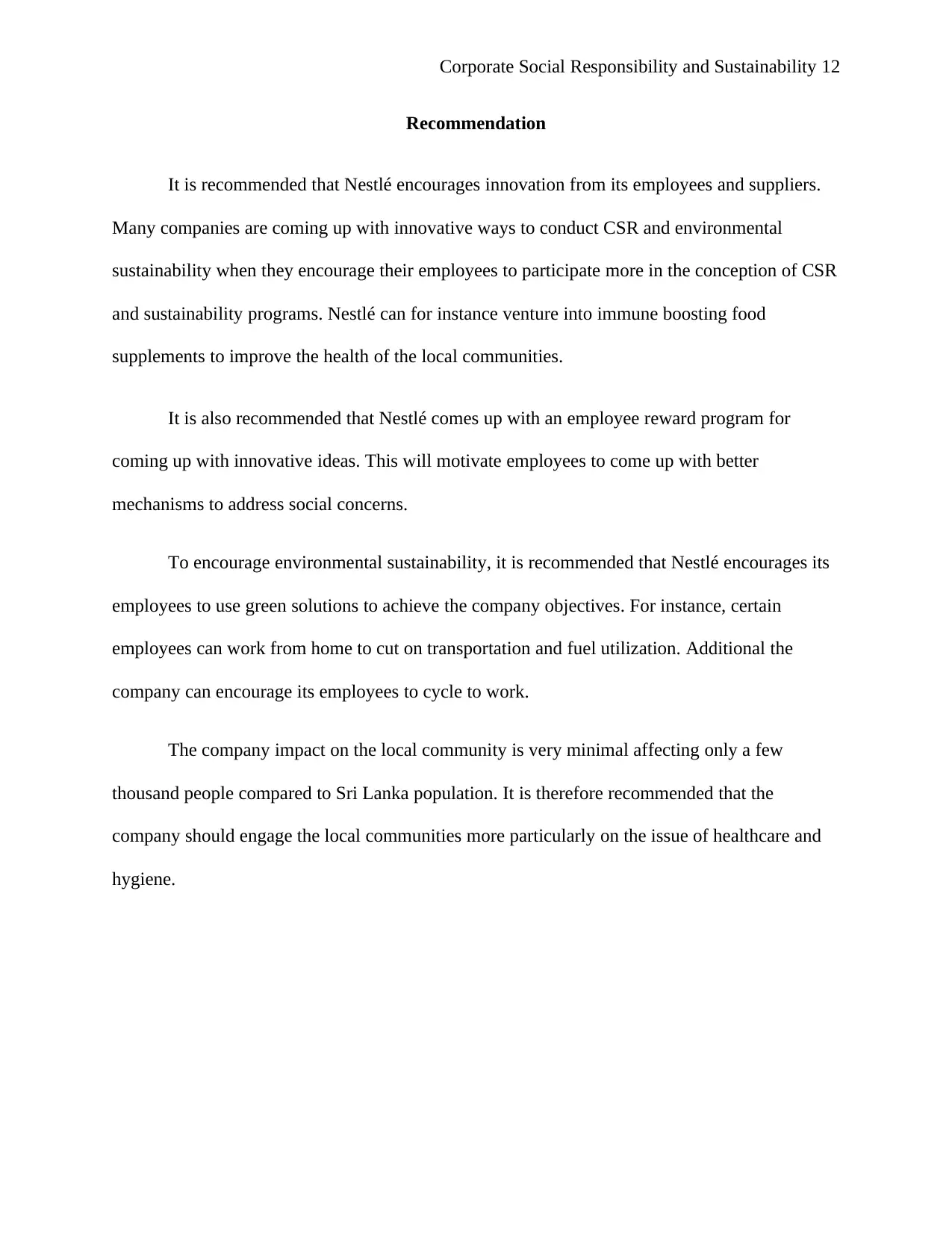
Corporate Social Responsibility and Sustainability 12
Recommendation
It is recommended that Nestlé encourages innovation from its employees and suppliers.
Many companies are coming up with innovative ways to conduct CSR and environmental
sustainability when they encourage their employees to participate more in the conception of CSR
and sustainability programs. Nestlé can for instance venture into immune boosting food
supplements to improve the health of the local communities.
It is also recommended that Nestlé comes up with an employee reward program for
coming up with innovative ideas. This will motivate employees to come up with better
mechanisms to address social concerns.
To encourage environmental sustainability, it is recommended that Nestlé encourages its
employees to use green solutions to achieve the company objectives. For instance, certain
employees can work from home to cut on transportation and fuel utilization. Additional the
company can encourage its employees to cycle to work.
The company impact on the local community is very minimal affecting only a few
thousand people compared to Sri Lanka population. It is therefore recommended that the
company should engage the local communities more particularly on the issue of healthcare and
hygiene.
Recommendation
It is recommended that Nestlé encourages innovation from its employees and suppliers.
Many companies are coming up with innovative ways to conduct CSR and environmental
sustainability when they encourage their employees to participate more in the conception of CSR
and sustainability programs. Nestlé can for instance venture into immune boosting food
supplements to improve the health of the local communities.
It is also recommended that Nestlé comes up with an employee reward program for
coming up with innovative ideas. This will motivate employees to come up with better
mechanisms to address social concerns.
To encourage environmental sustainability, it is recommended that Nestlé encourages its
employees to use green solutions to achieve the company objectives. For instance, certain
employees can work from home to cut on transportation and fuel utilization. Additional the
company can encourage its employees to cycle to work.
The company impact on the local community is very minimal affecting only a few
thousand people compared to Sri Lanka population. It is therefore recommended that the
company should engage the local communities more particularly on the issue of healthcare and
hygiene.
⊘ This is a preview!⊘
Do you want full access?
Subscribe today to unlock all pages.

Trusted by 1+ million students worldwide
1 out of 15
Related Documents
Your All-in-One AI-Powered Toolkit for Academic Success.
+13062052269
info@desklib.com
Available 24*7 on WhatsApp / Email
![[object Object]](/_next/static/media/star-bottom.7253800d.svg)
Unlock your academic potential
Copyright © 2020–2026 A2Z Services. All Rights Reserved. Developed and managed by ZUCOL.





